Hua Ka Hua–Restore Our Seed
A Public Seed Symposium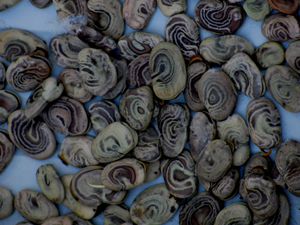
Photo: Beautiful fava beans. Photo by Nancy Redfeather.
Open-pollinated seed is being lost at a rapid rate. In the United States, 95% of seed varieties that were grown in 1900 are no longer available. These varieties were the backbone of the home garden and the market farm for centuries. The Kohala Center has received a grant through the USDA/OREI (Organic Research and Education Initiative) to hold a public Seed Symposium on April 17 and 18 at the Outrigger Keauhou Beach Resort in Kona. Farmers and gardeners from around the state will be sharing ways to grow, select, and save high quality seeds, as well as planning for a future public seed initiative to support research and an open-pollinated organic seed industry in the state.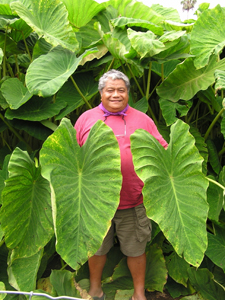
The symposium features presentations by statewide and national seed experts, including:
- Hector R. Valenzuela, Ph.D., Crop Extension Specialist, College of Tropical Agriculture and Human Resources (CTAHR), University of Hawai‘i (UH) at Mānoa;
- Theodore J.K. Radovich, Ph.D., Sustainable Farming Systems Laboratory, Department of Plant and Soil Sciences, UH Mānoa;
- Alvin Yoshinaga, Restoration Ecologist, Center for Conservation Research and Training, UH Mānoa;
- Matthew Dillon, Founder and Director of Advocacy, Organic Seed Alliance (OSA);
- Micaela Colley, Director of Research and Education, OSA;
- Frank Morton, Wild Garden Seeds in Philomath, Oregon;
- Jerry Konanui, expert in Hawaiian food plant varieties, their propagation, cultivation, harvesting, processing, and use throughout the islands.
Photo: Jerry Konanui says, "Maui lehua Kalo....so ono!" Photo by Gladys Konanui.
A free public lecture will precede the symposium from 5:30–7 p.m. Friday, April 16, at the resort. “The Story of Seed: Wild, Domesticated, Bred, and Engineered–Where Did We Begin and Where Might We Go?” will be presented by Dillon and Morton.
We feel that it will be of great benefit for university researchers AND farmers/gardeners to be together in the same room, something which seldom occurs. We hope that both groups will be illuminated by hearing each others mana‘o (wisdom). It is our greatest hope that statewide and island-wide seed working groups will emerge from this Symposium, as well as further workshops to gather knowledge, conduct variety trials, and coordinate field days to share seed and information on-farm, leading to production of high quality seed for both the home and market. —Nancy Redfeather, Coordinator of Hua ka Hua Seed Symposium and the Hawai‘i Island Seed Exchange
Learn more and register for the Symposium at http://www.kohalacenter.org/seedsymposium/about.html.
Take the Hua Ka Hua Hawai‘i Seed Initiative Survey. This Seed Assessment is intended for potential participants, to gather basic information about their interest in and knowledge of seed growing and saving. Information from the surveys will be used to assist us in planning a meaningful program for the Symposium.

A Day of Service
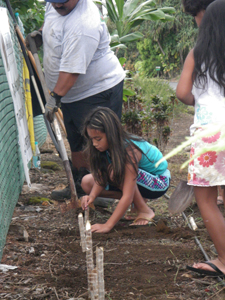
Photo: Makakapu Ioane, a third grader at Ka ‘Umeke Ka‘eo Public Charter School, planting ti in the school garden.
On January 18, in honor of Martin Luther King (MLK), Jr., and his commitment to community service, doctors and staff from Kaiser Permanente joined hands with students, teachers, and volunteers to work in three school gardens around Hawai‘i Island. “This is our way of giving back to our community,” explained Dr. Jeffrey Tolan, Family Practice Physician at Kaiser Permanente’s Waimea Clinic. Kaiser doctors, staff, and families across the state participated in the MLK Day volunteer effort—weeding, pruning, and planting crops in school gardens.
Kaiser’s health care professionals are seeing that the future will be changed through ‘education.’ They came out to share their mana‘o on health through proper nutrition and exercise, and they came to support the work happening in our school gardens. The Kaiser doctors understand that school gardens are meaningful community education projects that are reconnecting our keiki (children) and youth with their food and helping to change nutritional and lifestyle choices for students and their families. —Nancy Redfeather, Director, Hawai‘i Island School Garden Network
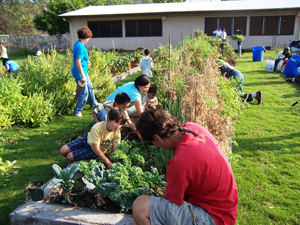
Photo: Kaiser Permanente’s community service day at the Kahakai Elementary School garden.
About 150 volunteers turned out, including plenty of keiki, at Ka ‘Umeke Ka‘eo Public Charter School in Hilo, where they planted ti, tended the school garden, and removed rubbish from the school grounds. “So much work got done with smiles and laughter,” says Pua Mendonca, Garden Teacher at Ka ‘Umeke, “and all ages worked together with lots of aloha.” More than 50 volunteers of all ages pitched in at Kaiser Permanente’s community service day at the Kahakai Elementary School garden, and 35 volunteers turned out at Mala‘ai: The Culinary Garden of Waimea Middle School. Working together, volunteers helped school garden teachers to rake grass clippings to use as mulch, to tend garden beds, to lay new weed mat, to plant seedlings, and to harvest produce.
The Kohala Center humbly thanks all of the Kaiser staff members and community volunteers who joined hands on MLK Day to help us realize a shared vision of health and wellness for island children and their families. Read more about the Waimea work day in “1000 Pairs of Hands” on the Back Page and about the Kahakai work day at http://www.westhawaiitoday.com/articles/2010/01/19/local/local02.txt.

Putting Their Energy into the Earth
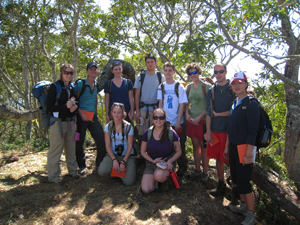
Photo: The 2010 Cornell EES cohort hiking on Pu‘u Huluhulu. Standing, from left to right: Nicki Button, Professor Alex Moore, Kirsten Sauer, Blake Adams, Lucas Waye, Emily Stephan, Alex Geilich, Catherine Kim. Seated, from left to right: Mary Rutz, Sonja Gabrielsen.
In 2010, the Cornell Earth and Environmental Systems (EES) Field Program welcomes nine students to experience life and learning on Hawai‘i Island. The EES Field Program enrolls undergraduate students with an interest in environmental science from any college or university: this year’s students were recruited from Cornell and from Rensselaer Polytechnic Institute. Students engage in a semester of hands-on study of the environment, based in the amazing natural “classrooms” that the island provides. The Cornell program is hosted by The Kohala Center with the collaborative mission to inspire stewardship of the Earth though first-hand experience with the power—and fragility—of Earth’s interconnected systems. Faculty from the U.S. Mainland and Hawai‘i Island work with students to explore terrestrial and marine ecosystems and their conservation. The program also explores the intersection of indigenous and western scientific traditions, as faculty engage the students in an ongoing discussion of Hawaiian history, culture, and world views.
In the face of global climate change, EES participants are committed to creating a carbon-neutral program. This was accomplished for the first time in 2009. Students tallied all of the primary emissions from program activities, including all air travel, ground travel, domestic gas and electricity use, food, and waste. “While reducing emissions is the best means of achieving carbon-neutrality, those emissions that cannot be eliminated are offset by planting trees,” explains Dr. Alexandra Moore, director of the EES Program. Working with two partners, the Dryland Forest Working Group at Ka‘ūpūlehu and the Kohala Watershed Partnership, 2009 EES faculty and students outplanted 250 native trees. Tree planting restores degraded dryland forest ecosystems and sequesters fossil-fuel-derived carbon for hundreds to thousands of years. The 250 trees are calculated to absorb 250 tons of carbon, more than enough to offset the 69 tons of carbon emitted by the EES group during their stay on the island.
It is important for everyone to have a basic idea of the size of his or her carbon footprint and the components that contribute to it. Beyond that, we discovered that living carbon-neutral is easy and fun. We meet great people, work in unique ecosystems, and we get to help restore native forests locally, while preserving the environment globally. Putting our energy into the Earth instead of taking it out is a win-win situation for all. —Dr. Alexandra Moore, Director of the Cornell EES Field Program
Nine of last year’s students submitted a paper describing their carbon-neutral semester, "What Does It Take to Be Carbon-Neutral," to the Geological Society of America Annual Meeting in October 2009 in Portland, Oregon. Read their abstract at http://gsa.confex.com/gsa/2009AM/finalprogram/abstract_161935.htm.
This year the EES group will continue to tabulate their emissions and outplant native tree species, as well as monitor the areas reforested in 2009 in order to assess the rate of tree growth and actual carbon storage capacity of Hawaiian forest ecosystems.

Whalewatch Village Design
Photo: This “Hawai‘i Hygiene Hut,” or “H3,” structure could potentially satisfy Department of Health requirements at a much lower cost than a traditional cesspool or septic system.
How do we encourage farmers to live on the land? Professor Jan Wampler and a group of Massachusetts Institute of Technology (MIT) architecture students have spent the last few months designing a small farm dwelling to be part of a clustered agricultural community in North Kohala, tentatively named by the landowner “Whalewatch Village.” The MIT group spent time on the island in October becoming oriented to local planning issues, meeting with key community members and government officials, and collecting information about community planning concerns and desired planning parameters. Back at MIT, they designed the housing, village, overall plan, and a small structure called “H3.”
The MIT students were tasked with exploring the feasibility of using local materials and resources in their building design. “All of us, everywhere, must start doing this, explains Professor Wampler. For too long we have been dependent on outside resources—literally, the whole world—for our materials and food. This must stop, and this was our big challenge, but also an exciting new future,” Wampler says.
Wampler and the students designed a cluster of ten dwellings plus a community building, which they hope can be constructed with locally sourced bamboo. They also designed the “H3” structure to house an approved composting toilet, a shower, and a sink. MIT planning students are now working to calculate the costs of building the proposed structures, presuming that construction would be locally based, utilizing local bamboo. MIT students are also reviewing Hawai‘i County’s current building and zoning codes to assess changes that might need to be made to these codes to permit such structures to be built on the island. One product of the students’ work will be to outline proposed amendments to current codes to expedite construction of affordable farm dwellings on the island.
Hawai‘i Island has the will to work for a better life. This island has the opportunity to show many places in the world how to create a new future. My students and I would like to continue working on the island. —Professor Jan Wampler
The Kohala Center hosted a public presentation of MIT designs for interested community members on Friday, January 8, in North Kohala. Over sixty people attended this presentation by Professor Wampler and his team, and the presentation was well received by the audience. View the PowerPoint for Whalewatch Village design.
Read “The Next Generation of Architects” and “Designing Affordable Farm Dwellings” in the November/December issue of The Leaflet.

Very Beneficial Scholarship Opportunities
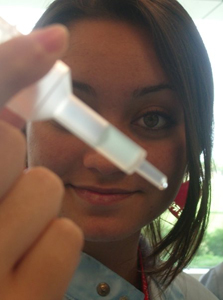
Photo: Alyxandra Hopkins proudly presents the pure plasmid DNA that her group isolated in microcentrifuges at last summer’s CATALYST Academy. To get this final product, they had to meticulously spin, lyse, bind, wash, and elute pelleted bacteria.
The Kohala Center invites high school students to apply for scholarships to summer engineering and environmental science programs at Cornell and Brown universities. Applications are due February 26 for the Cornell CATALYST and CURIE academies’ one-week residential engineering programs and for the Brown University Environmental Leadership Lab (BELL) this summer.
The CATALYST Engineering Program was an extraordinary experience that I shall always fondly remember. I had not been particularly interested in pursuing engineering, but this program was very beneficial to me. I learned that engineering encompasses almost every aspect of life and can be applied in every field. I was privileged to work in state of the art laboratories to produce fluorescent proteins and network with other motivated peers from around the nation and the world. —Alyxandra Hopkins, senior at Saint Josephs High School and 2009 CATALYST Academy scholarship recipient
BELL brings together students with open minds and big hearts. One of the best aspects of the program is purely the pure passion you feel from each and every fellow student at BELL. This place makes you question everything. Being pushed academically and emotionally, as well as physically, changes you as person and I believe it is for the better. —Grace Franchini, junior at Hilo High School and 2009 BELL scholarship recipient
Learn more about these extraordinary learning opportunities in “Once in a Lifetime Experiences” on the Back Page.

Managing Human Impacts
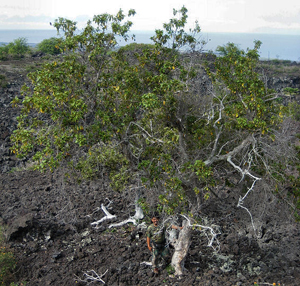
Photo: Sam Gon under a large kauila tree in the dry forest at Kapu‘a, South Kona. Kauila (Colubrina oppositifolia) was one of the hardest and most desired woods for tools and weapons in ancient Hawai‘i. “It is so hard to find a large kauila tree under which to stand these days,” says Gon.
Hawai‘i’s dry forests are home to many of the rarest plants in the world. Only remnant patches of dry forest habitat remain, though dry forests once dominated the landscape of West Hawai‘i.
The 2010 Nāhelehele Dry Forest Symposium on Friday, February 26, will address dryland forest ecology and restoration efforts in Hawai‘i. Sam Gon, senior scientist and cultural adviser with The Nature Conservancy, will share scientific and cultural perspectives on dry forest plants and ecosystems. Dry forest systems have the highest tree diversity of any Hawaiian forested ecosystem, and dry forests once provided the vast majority of hardwoods, as well as important seasonal foods. Hawai‘i has now lost roughly 90% of its dry forests and 90% of their constituent species.
When a Hawaiian thinks about dryland forest, he might think about the rich array of woods that provided shelter, tools, weapons, transportation, recreation, fire, etc. When you come across place names such as ‘Aihualama (to eat the fruit of lama trees), you know how important the lama dry forests were at that place to provide seasonal food. It is a sorry situation indeed to think about the nearly total loss of such a culturally important ecosystem that once surrounded Hawaiians and strongly influenced their material and intellectual culture. —Sam Gon, The Nature Conservancy
The Nāhelehele Symposium brings together researchers and conservationists to discuss strategies for keeping the remaining dry forests healthy and for restoring these habitats where possible. The primary audience for the symposium is conservation professionals and volunteers, but many of the presentations and discussions will be of interest to the general public as well. This year’s conference will emphasize managing human impacts on Hawaiian dry forests.
Read more about the “Nāhelehele Dry Forest Symposium” on the Back Page.

Chocolate!

Photo: Cacao pods ripening on the tree at Kuaiwi Farm. Photo courtesy of http://www.kuaiwifarm.com.
Growing cacao and making chocolate candy is a challenging experience, but the end product is worth the work! Participants, even the chocoholics, will definitely get their fill of chocolate. And they will take home a sample bag of goodies. —Una Greenaway, Kuaiwi Farm
Friends of The Kohala Center are invited to experience Chocolate Growing and Candy Processing on Kuaiwi Farm on Saturday, February 13, from 9 a.m.–1 p.m. This is the second in a series of four learning events sponsored by The Kohala Center in 2010, focusing on “The Birds and the Bees and a Little Bit of Chocolate.” Hosts Una Greenaway and Leon Rosner will lead participants on a tour of their five-acre organic farm in Kealakekua. Several crops are grown and processed right on site, including coffee, macadamia nuts, and chocolate. Participants will learn the steps involved in making chocolate candy, from harvest to the final product. And everyone will be invited to sample the farm’s homemade chocolate. Mmmm!
A picnic lunch is included. For information about this and other Learning Events, contact The Kohala Center at info@kohalacenter.org or 808-887-6411. Cost is $25 per event for current Friends of The Kohala Center; $75 for new Friends, which includes an event. To learn more about the Circle of Friends, visit http://www.kohalacenter.org/join.html.
The Kohala Center’s learning events encourage participants to connect with one another, with cultural and scientific experts, and with Hawai‘i Island’s natural, cultural, and spiritual landscapes. Other trips planned this year are Beekeeping and Volcano Island Honey with Richard Spiegel on March 20, and the Keauhou Bird Conservation Center and Kipuka Puaulu with Jack Jeffrey on May 15.


Subscribe to Kalei Nu‘uhiwa's Hawaiian Moon Newsletter.
Please click here and then send from your e-mail. Mahalo!

